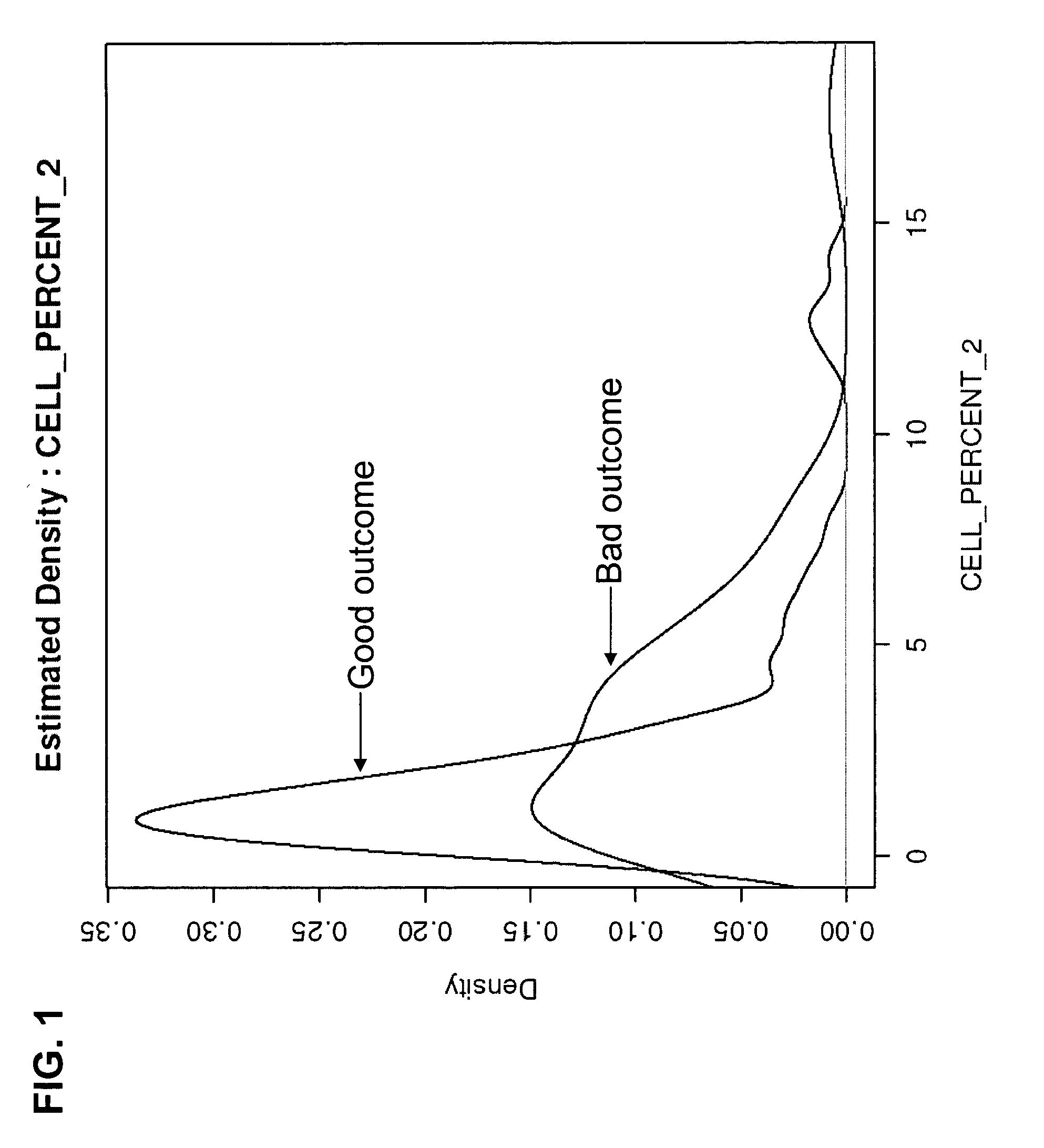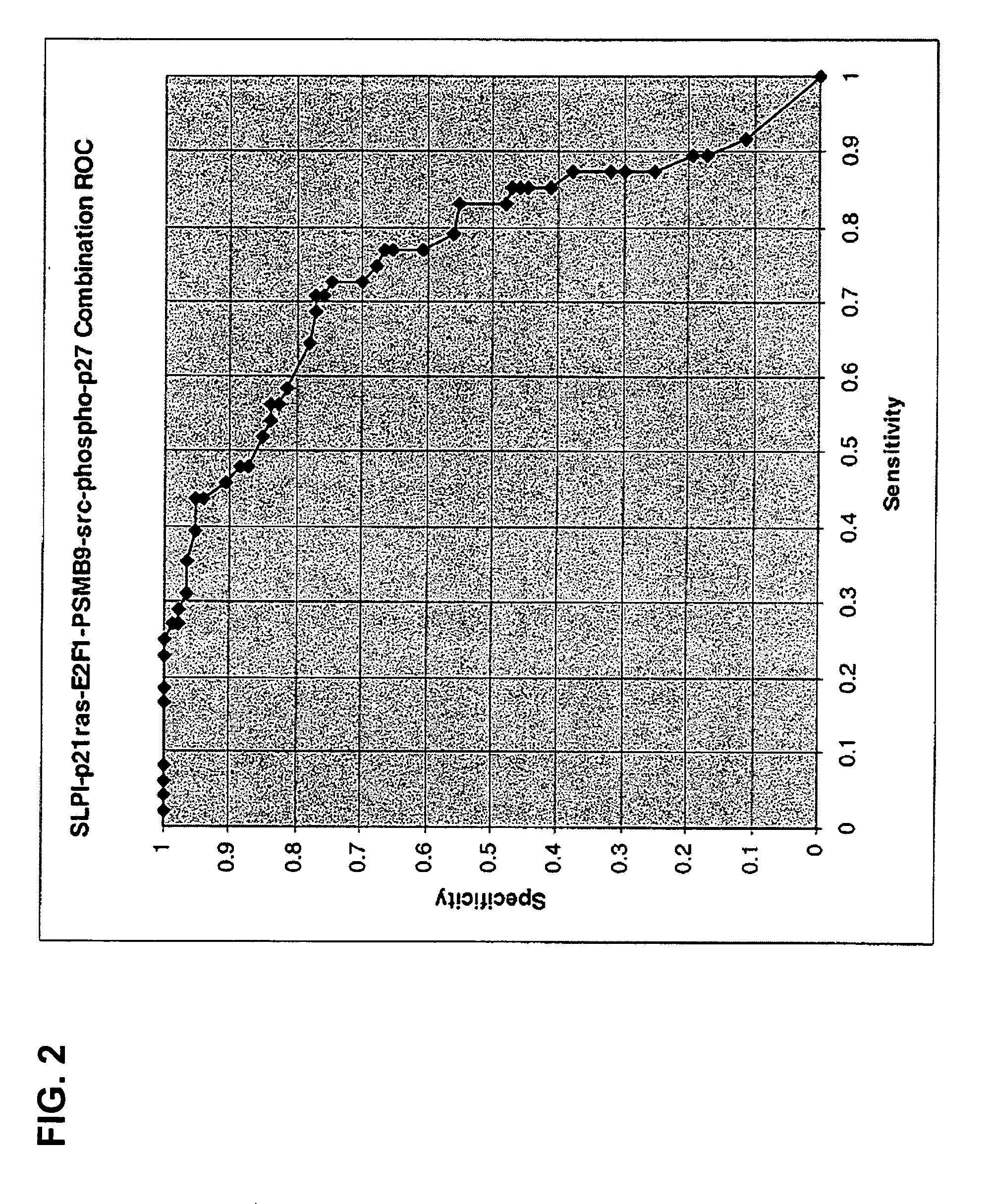Methods and compositions for evaluating breast cancer prognosis
a breast cancer and prognosis technology, applied in the field of breast cancer prognosis evaluation methods and compositions, can solve the problems of poor ten-year outcome of approximately 20% of women diagnosed with early-stage breast cancer, recommendation of aggressive adjuvant therapy, and no widely used assay to risk stratify patients for more aggressive treatment. , to achieve the effect of accurate evaluation of breast cancer prognosis and good prognosis
- Summary
- Abstract
- Description
- Claims
- Application Information
AI Technical Summary
Benefits of technology
Problems solved by technology
Method used
Image
Examples
example 1
Detection of Biomarker Overexpression Using Immunohistochemistry
Slide Preparation
[0105] 4 μM sections of formalin-fixed, paraffin-embedded breast tumor tissue samples are cut using a microtome and placed on SuperFrost+ slides (VWR). The slides are baked in a forced air oven for 20 minutes and then contacted with a Histo-Orienter until the paraffin melts. Slides are washed three times with xylene for 5 minutes to remove paraffin and then rinsed three times in absolute alcohol at 2 minutes / rinse.
Pretreatment and Antigen Retrieval
[0106] To prevent non-specific background staining, the slides are incubated in a hydrogen peroxide / methanol block for five minutes at room temperature. Slides are then rinsed thoroughly with several changes of dH2O.
[0107] In order to make the antigens accessible to antibody binding, slides are incubated in an antigen retrieval solution in a pressure cooker for 5 minutes. Slides are allowed to cool to room temperature for 20 minutes on the bench, and th...
example 2
Detection of Overexpression of Individual Biomarkers in Clinical Samples
[0112] Approximately 130 breast tumor tissue samples from patients at various disease stages were collected. The average patient age was 77. Actual clinical outcome data for each patient was known, and each patient was categorized as having a good or bad outcome. In this study, good outcome was defined as remaining cancer-free for at least 5 years; bad outcome was defined as suffering disease relapse, recurrence, or death within 5 years. The following table indicates the number of samples within each diagnosis group analyzed, as well as actual clinical outcome data.
TABLE 1Clinical Samples AnalyzedStageGood OutcomeBad OutcomeTotalT1N0501363T1N16410T2N0261945T2N19716T3N0033T3N1011Lymph Node StatusGood OutcomeBad OutcomeN07635N11512
[0113] The samples were analyzed by the automated immunohistochemistry described in Example 1 to identify biomarkers whose overexpression is indicative of a bad cancer prognosis. That...
example 3
Detection of Biomarker Overexpression in Clinical Samples—Combining Biomarkers
[0130] In order to determine if the sensitivity and specificity of the methods of the invention could be improved if multiple biomarkers were combined, the data from Example 2 was subjected to further analysis. Thus, various combinations of biomarkers were considered, and samples that stained positive for any of the biomarkers in the combination of interest were deemed positive. These results were compared with the known actual clinical outcome data available for each patient, and each slide was then given a final result of true positive (TP), true negative (TN), false positive (FP), false negative (FN) as before. Sensitivity, specificity, positive predictive value (PPV), and negative predictive values (NPV) for each combination of biomarkers were calculated.
Results
[0131] The results for each combination of biomarkers are summarized below.
TABLE 5SLPI, PSMB9, MUC-1, and phospho-p27TP24FP25FN23TN58Sens...
PUM
| Property | Measurement | Unit |
|---|---|---|
| pH | aaaaa | aaaaa |
| pH | aaaaa | aaaaa |
| pH | aaaaa | aaaaa |
Abstract
Description
Claims
Application Information
 Login to View More
Login to View More - R&D
- Intellectual Property
- Life Sciences
- Materials
- Tech Scout
- Unparalleled Data Quality
- Higher Quality Content
- 60% Fewer Hallucinations
Browse by: Latest US Patents, China's latest patents, Technical Efficacy Thesaurus, Application Domain, Technology Topic, Popular Technical Reports.
© 2025 PatSnap. All rights reserved.Legal|Privacy policy|Modern Slavery Act Transparency Statement|Sitemap|About US| Contact US: help@patsnap.com



